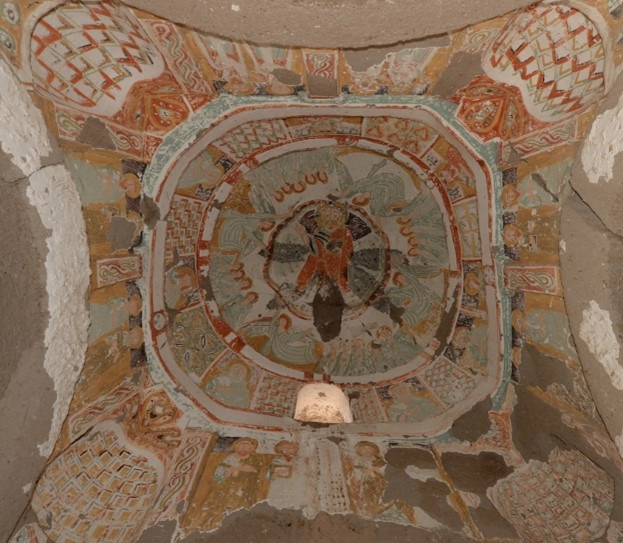Agacalti Church
Ağaçaltı Church – Icon of Ihlara Valley (Aksaray)
Architecture and Historical Background
Located at the northern entrance of Ihlara Valley, Ağaçaltı Church is the first rock-cut sanctuary to greet visitors as they step into the canyon. Built between the 9th and 11th centuries, it reflects early Byzantine style.

The church features a central dome on a high drum, three barrel-vaulted arms forming a cross, and finely carved stonework. Originally entered through its western façade, today visitors approach from the valley floor, ascending into the church a unique experience.
Restored in the 1960s and now under the care of the Aksaray Museum Directorate, it remains one of the valley’s most visited monuments.
Artistic Richness and Fresco Program
The frescoes of Ağaçaltı Church are among the most colorful in Ihlara Valley, painted with vivid pigments: jade green, lapis blue, golden yellow, and deep red.

Key scenes include:
- Koimesis (Dormition of the Virgin)
- Anastasis (Christ’s Descent into Hell)
- Ascension
- Daniel in the Lion’s Den
- Baptism of Christ
- Last Supper
At the center of the dome stands Christ Pantocrator, surrounded by the Twelve Apostles and the Four Church Fathers. Narrative cycles cover the vaults and apses, acting as a “visual Bible” for monastic communities and the faithful.
The stylistic parallels with nearby Daniel Church suggest shared artistic workshops. Simple facial features and strong outlines emphasize clarity of teaching over ornament.
Cultural and Geographic Context
Ihlara Valley, carved by the Melendiz River, stretches for 14 km and is lined with monasteries, hermitages, and over 100 churches. Ağaçaltı stands out as one of the most accessible and frequently visited.
The name “Ağaçaltı” (“Under the Tree”) comes from a large tree that once stood in front of the church. Locals also call it the “First Gate” or “Beginning Church”, reflecting its position at the start of the valley pilgrimage route.
For early monks, it served as a retreat; for local villagers, it was a center of worship and communal gathering.
Visiting Information
- Location: 35 km from Aksaray, 1.5 km from Ihlara village
- Transport: Hourly minibuses from Aksaray to Ihlara; short walk (5–10 minutes) from the valley’s north gate
- Tickets: Included in Ihlara Valley entrance; no extra fee
- Opening Hours: Summer 08:30–18:30 (check locally for seasonal changes)
- Facilities: Parking at the valley entrance; ticket booth nearby
Tips:
- Wear sturdy walking shoes; trails are rocky and uneven
- Bring water, sunscreen, and a hat in summer
- Carry a flashlight for dim interiors, but avoid direct light on frescoes
- Photography without flash is permitted; tripods useful but space is limited
Suggested Routes
After visiting Ağaçaltı, continue along the Ihlara trail to explore:
- Sümbüllü Church
- Yılanlı Church
- Daniel Window and Daniel Church
- Kokar and Pürenli Seki Churches
At the end of your hike, enjoy local handicraft shops or tea houses in Güzelyurt, where rock-carved architecture still shapes the townscape.
Experience
Ağaçaltı Church embodies both the artistic richness of Byzantine Cappadocia and the spiritual depth of Ihlara’s monastic heritage. With its vivid frescoes, commanding dome, and symbolic place at the entrance to the valley, it offers visitors a perfect introduction to Cappadocia’s sacred canyon.



